Header logo
header top contact widget
Dental Technology
Advanced Skills & Technology Enhance Comfort, Speed Healing
Posted on Apr 27, 2021 by William J. Claiborne, DDS MS
If you’ve ever watched a cabinet maker, his skill and attention to detail is impressive. He knows the various wood types, understands the details of joints and angles, and respects the individual components as interacting pieces that will work harmoniously as a whole.
Because he has the tools and skills specific to his craft, the coming-together of this typically provides a ‘forever’ result.
In the periodontal specialty, our specific skills create a number of advantages for patients who have different needs. Some of these skills are not always obvious, yet they allow for a higher level of success, greater comfort, and less time required for healing.
A periodontist, as defined by the American Academy of Periodontology (perio.org), is:
“A periodontist is a dentist who specializes in the prevention, diagnosis, and treatment of periodontal disease, and in the placement of dental implants. Periodontists are also experts in the treatment of oral inflammation. Periodontists receive extensive training in these areas, including three additional years of education beyond dental school. They are familiar with the latest techniques for diagnosing and treating periodontal disease, and are also trained in performing cosmetic periodontal procedures.”
As an Asheville periodontal specialist for over 25 years, I’ve utilized my advanced skills to help patients with a variety of needs that involve the gum tissues. These include:
– Treatment of all stages of gum disease (gingivitis, pregnancy gingivitis, periodontal disease, periodontitis)
– Reshaping gum tissues for esthetic enhancement (crown lengthening, gingivectomy for ‘gummy smiles’, repairing areas of gum recession)
– Diagnosis and placement of dental implants
– Treatment of lesions or cysts in oral tissues
Although there are other treatments offered, our main goal is to provide the patient with a comfortable and positive experience within our specialized skills. We believe that patients will come to appreciate the advantages of having a healthy smile and understand how our involvement can create a healthier, more confident individual.
Here, our Western North Carolina periodontal dental office features some of the most advanced technology in dentistry. Many of these are not available in other dental offices elsewhere. Some of these features include: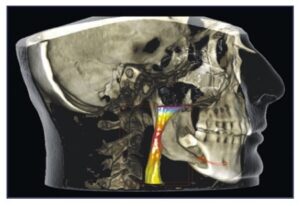
LANAP With PerioLase MVP 7 – Laser-Assisted New Attachment Procedure is an advanced protocol that efficiently and effectively treats advanced gum disease with the added advantages of a dental laser. This offers a non-surgical alternative for patients with moderate to severe periodontal disease. LANAP treatment leaves very little discomfort and has a quick recovery time. It has also been found to stimulate bone regrowth in damaged areas.
3-D Cone Beam Imaging – Ideal for diagnoses and treatment planning, these images provide a clear view of the upper and lower jaw, used for: intricate review of endodontics; periodontics; orthodontics; implantology: TMJ; and prosthodontics, as well as dental and maxillofacial surgery. Because cone beam radiographs show sagittal, axial, and coronal planes, locating and tracking nerve canals optimizes implant placement. The process is quick, painless and at minimal levels of radiation.
CareStream Cone Beam Computer Tomography Imaging – This enhanced tomography works with 3D imaging for exceptional detail and range.
CS 3600 Intraoral Scanner – Rather than make impressions with bulky, goopy trays, this scanner quickly and comfortably captures digital impressions accurately and easily for creating precision models or appliances (crowns, inlays, onlays, bridges, orthodontic appliances and aligners, custom abutments). The scanner can also reach difficult–to–access areas in the patient’s mouth for superior results with improved patient comfort.
Computerized Dental Implant Placement – This advanced system for pre-surgical positioning of dental implants uses a 3D model of the patient’s jaw. Once the implant type is selected, a template is developed for optimal treatment success, even for complex cases.
In addition, we offer a unique environment for comfort. We understand how dental fear or anxiety can cause people to delay or avoid having dental treatment, sometimes for decades. Too, when regular dental cleanings and check-ups are not maintained, the results often culminate into more complex problems (and necessary repairs) in the future.
We help patients understand that these fears and concerns are not unusual. Our doctors and staff respect each patient and provide gentle, compassionate care – at every appointment.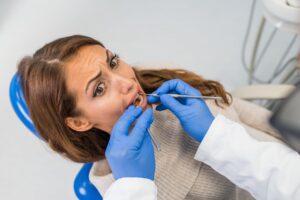
For those who have high fear levels, we offer several sedation options, including oral and IV sedation. Oral sedation is a pill that helps patients relax. It also has an amnesiac effect, leaving most with little or no memory of treatment afterward.
I.V. sedation (also known as ‘twilight sleep’) places the patient in a deeper sleep state and erases memory of the procedure. It is administered by a doctor of anesthesiology for optimal comfort and safety. In our Asheville office, anesthesia is overseen by a Medical Doctor (MD) who is a board certified Anesthesiologist.
With both sedation options, patients are closely monitored with advanced safety equipment throughout treatment.
How I would describe the difference between a periodontist and other dental specialists is in how gentle and respectful we are to the tissues in the mouth. These are tender layers that significantly affect the appearance of a smile and the health of teeth. By understanding the techniques to minimize incisions while effectively treating each area in the mouth, a periodontist is your expert.
We feel you’ll find no better periodontal dental environment. Call 828-274-9440 to learn more or to schedule a consultation appointment. New patients are always welcome and a referral is not required.
Know The Qualifications of Who Places Your Dental Implants.
Posted on Apr 05, 2021 by William J. Claiborne, DDS MS
When someone has lost a natural tooth, the word that stands out for me is “lost”. A missing tooth means a lot can be lost.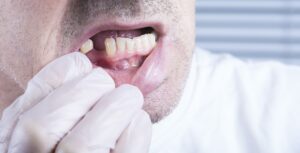
Tooth loss not only leaves a gap in the appearance of a smile, its absence can lead to movement of surrounding teeth.
For example, some people assume that a lost back tooth that is not visible doesn’t need replacing. This is an incorrect assumption. Without all teeth in their proper positions, a gap can cause others to tilt and turn. Additionally, the one above or below will grow longer. These misalignment issues can lead to broken, fractured, or chipped teeth.
Misaligned teeth can also lead to strain on the TMJ, or jaw joints. These joints, located on each side of the head just in front of the ears, are hinges that connect the lower jaw bone to the skull. They are in motion almost constantly.
When the jaw joints experience frequent strain from misaligned teeth, they can cause pain that extends out to head, neck and shoulder muscles. TMJ-related pain can be the source for headaches, migraines, facial pain, ear ringing, dizziness, pain when chewing and difficulty opening the mouth fully.
Obviously, replacing teeth is important. Because of many factors, a dental implant is the superior choice in tooth replacement. A dental implant is a lifetime replacement option. Dental implants restore the ability to bite, chew, speak and laugh confidently without worry. The security of their strength and stability can also be greatly beneficial to one’s self-esteem and self-confidence.
Too, dental implants actually enhance the well-being and lifespan of surrounding teeth. They are an exceptional value when considering their ability to restore the most natural look, feel and function.
In dental implant treatment, the implanted portion is positioned in the jaw bone as a tooth root replacement. This provides attached teeth with the same foundation as natural tooth roots. A partial or bridge simply sits on top of gum tissues and relies on adjacent teeth for support.
Yet, it can be in WHO is involved in your dental implant diagnosis and placement that can provide you with optimal comfort and lifelong success.
When dental offices offer dental implants, many general dentists refer the placement portion to a periodontal specialist. For their patient, this can mean a higher level of comfort and success, especially for complex needs.
However, some dentists offer dental implant placement in their offices. While some have taken extensive courses in implant dentistry, others may have taken a weekend course here and there. These quick courses are typically hosted by an implant manufacturer who trains attendees with a limited selection of implant types. This can limit the patient’s choices when relying on appropriate recommendations for his or her unique needs.
Although there are many factors to go forward with a dental implant, your choice of doctor to place the implanted portion can greatly increase your potential to enjoy your dental implant for a lifetime.
As a periodontist, an aspect of the specialty is the advanced training in the diagnosis and placement of dental implants. This specialized expertise affords patients with a wider variety of choices when it comes to implant systems as well as success in treatment outcome.
For example, consider a patient who is missing a lot of bone mass (often due to missing natural teeth for many years). An implant placed in the upper jaw in too-shallow bone can work its way into the sinus cavity. A lower implant in insufficient bone depth can reach a nerve that runs horizontally through the lower jaw (the mandible).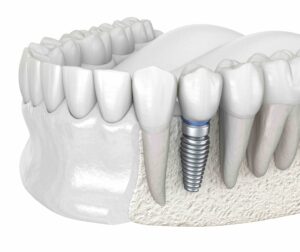
Additionally, the shape, size and the number of teeth to be attached to an implant have much to do with the type of implant system selected. When the placement doctor is only familiar with one or two types, the limitation may pose problems for the patient in the future.
Along with an intricate knowledge of the specific type of implant needed, proper placement angles and depth have much to do with the overall success of the implant. For optimal results, the doctor placing the implant should be skilled in the selection of the implant angles and positioning depths.
In our Asheville periodontal office, we restore the well-being of smiles. We also help patients replace bothersome dentures or partials so they can resume eating the foods they love and laugh confidently in social gatherings.
The doctor is not the sole factor in success, however, Along with proper selection and placement, a patient must take measures to ensure proper oral hygiene at home. Oral bacteria can contribute to an infection that works its way into the bone surrounding the implant. In some cases, the only way to resolve the infection is to remove the implant.
The most troubling thing I see in implant dentistry is when a patient opted for a “good deal” with a less-experienced doctor, and having to remove a ‘failed’ implant.
When a patient entrusts their implant treatment to a skilled doctor and adheres to hygiene and healing guidelines, having an implant fail is very unlikely. The success rate of today’s implant dentistry is excellent – over 97 percent.
Today’s implant dentistry is successful, safe, dependable and can provide nearly immediate benefits. As a dental specialist who has stayed on the cutting edge of implant dentistry’s techniques, technology and materials, I am pleased to witness the transformations our patients undergo after treatment.
The type of dental implant best suited for you can be determined after an examination and review of x-rays (we use Cone-Beam digital imaging). Call 828-274-9440 to begin with a private, no obligation consultation to discuss your best options.
Flossing – A Valuable Step In Avoiding Gum Disease & Tooth Loss
Posted on Mar 17, 2021 by William J. Claiborne, DDS MS
Adults who wish to stay healthy and active as they age often workout daily, walk at least 30 minutes per day, try to get 7 – 8 hours of sleep each night, and brush their teeth twice a day.
Tooth brushing helps to keep oral bacteria levels in the mouth to manageable levels. With the help of saliva, which is a rinsing agent for the mouth, these bacteria are generally kept under control. By preventing rampant growth, the ‘oral cavity’ (interior of the mouth) is able to avoid a destructive onslaught caused by these icky organisms.
A study shared by Dental Dental showed that about 70 percent of American adults brush their teeth twice a day. Unfortunately, this leaves more than a fourth of adults who do not.
Daily flossing is also recommended by the American Dental Association (ADA) as a preventative way to keep cavities and gum disease at bay. Still, an estimated 30 percent are committed to daily flossing – less than a third.
This means that a whopping 70 percent do not include flossing in their daily oral hygiene regimens. Too, about a third of Americans admit to never flossing, with 39 percent of men and 27 percent of women who do not.
Yet, the devotion of twice daily brushing and daily flossing requires only about 5 minutes of time – total. It is recommended to spend two minutes brushing teeth in the morning and before bed. A practiced flosser requires about a minute to floss. (Consider that five minutes is about the amount of time for a commercial break between TV programs.)
Yet, if you could see what I see…
As a periodontist, my specialty includes advanced training in the treatment of gum disease. I know the destructive nature of infectious oral bacteria. I have a bird’s eye view of what can occur without a committed oral hygiene routine at home. When an overload of bacteria accumulate in the mouth, cavities are able to form and gum tissues become food for living and breeding bacteria.
While brushing twice a day is important, the bristles of a toothbrush are typically unable to dislodge food particles caught between teeth. Left behind, these particles begin to rot rather quickly, leaving even more sustenance for bacterial growth and reproduction.
To see just how much your toothbrush misses, brush your teeth thoroughly for the recommended two minutes at the end of the day. Rinse and spit a couple of times. Then, using a strand of floss, move gently between teeth, easing up and down to reach the sides of all teeth. Move the floss just slightly beneath the gums at the base of each tooth. After all teeth are flossed, rinse and spit again. Most people are shocked at just how much their toothbrush failed to remove.
When oral bacteria amass past the point that is manageable by the immune system, these bacteria become infectious. This causes inflammation in the gum tissues, which can lead to the formation of periodontal (gum) disease. This begins with gingivitis, which has mild symptoms. Untreated, it worsens to periodontal disease and the advanced level of periodontitis.
It begins when oral bacteria accumulation creates a sticky film in the mouth known as plaque. When not removed thoroughly and frequently, plaque can form cement-hard bacteria colonies that attach to teeth. This hardened form of bacteria is known as tartar and, once formed, can no longer be brushed or flossed away.
As a Periodontist, I often see people who have developed periodontal disease who come (or have been referred) because they have obvious symptoms, such as red, swollen gums. However, I also see patients who are surprised to learn they have developed the disease. Yet, even without obvious symptoms, gum disease may exist and be fully underway.
Nearly half of American adults have some level of gum disease (over 47 percent in recent estimates). Periodontal (gum) disease is the nation’s leading cause of adult tooth loss even though it’s one of the most preventable of all diseases with simple measures.
Losing natural teeth leaves an individual with having to make decisions for replacement – crown-&-bridge combination, partial denture, full denture or Dental Implant. These time-consuming procedures and expenses can be avoided. And, contrary to what many believe, losing teeth is not a natural part of the aging process. With proper care, you can easily enjoy a smile of natural teeth all your life.
It is often surprising to people to learn that oral health is an integral part of overall health. Inflammation in the mouth doesn’t simply remain in the mouth. Through tears in diseased gum tissues, the oral bacteria of gum disease are able to enter the bloodstream. As the bacteria travel throughout the body, their toxic nature can activate inflammatory effects elsewhere.
Infectious gum disease bacteria have been the focus of a numerous amount of research over the years. Studies have found that the bacteria of gum disease can trigger or worsen heart disease, stroke, preterm babies, arthritis, diabetes, some cancers, Alzheimer’s disease, erectile dysfunction (ED) and impotency. As research continues, even more serious (and deadly) connections are being made.
They key is to keep oral bacteria levels to a minimum, which is why brushing and flossing are an important part of your daily care routine. Neither step should be taken for granted. Yet, as a periodontal specialist, I understand how it can be difficult to get into the habit of daily flossing.
For some, the tight floss around fingers is uncomfortable. For others who have large fingers or problems with manual dexterity, the act of flossing is awkward or challenging. However, for those who floss on a daily basis, it becomes a maneuver that is as simple as brushing teeth.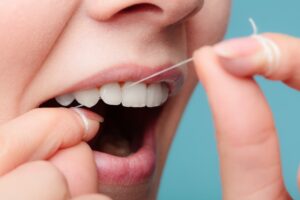
For individuals who are challenged by manual flossing, there are some excellent water flossers on the market. These are affordable and can be just as effective as ‘string’ flossing when used properly – and daily.
Twice daily brushing (at least two minutes per time), daily flossing, drinking ample water and limiting sweets and caffeine are simple ways to keep your mouth healthy between regular dental check-ups and cleanings. And, those 6-month check-ups are important. During these visits, tartar that may have formed can be removed and signs of early gum disease can be addressed.
If you are experiencing symptoms of gum disease, call 828-274-9440. In our state-of-the-art Asheville periodontal dental office, our patients are treated with respect, compassion and a gentle touch. Here, you’ll never be lectured. Our goal is to restore your smile to a healthy state and develop a program to help you keep it at its best.
New patients are always welcome. A referral is not needed to become a patient.
Tooth Loss Cause of Shrinking Face, Sunken-In Mouth
Posted on Jan 14, 2021 by William J. Claiborne, DDS MS
The aging process is not an easy one. Joints begin to creak, muscles are more easily strained, skin dries out, eyesight wanes and hearing declines.
Yet, throughout the aging process, some adults seem to go through it as less of an ordeal than others. Although diseases and certain health conditions can occur regardless of how well some people manage, some people take a number of steps that can have a significant impact on aging well and “getting old.”
The basics of good health include a diet low in sugar, alcohol and unhealthy fats. NOT smoking is a 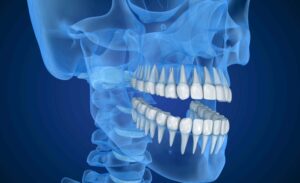 big factor in maintaining a healthy body. Regular exercise, sufficient sleep and regular physicals and dental check-ups are all beneficial.
big factor in maintaining a healthy body. Regular exercise, sufficient sleep and regular physicals and dental check-ups are all beneficial.
A factor that plays a bigger role in having good overall health is having natural teeth. Having the ability to comfortably bite and chew food is important to effective digestion, since the digestive process begins in the mouth. When adults struggle to eat with a denture or partial, the efficiency of this initial stage of digestion is compromised.
It’s not unusual for adults who have “rocky” or “slippery” dentures to opt for soft foods that dissolve easily in the mouth. These are often carb heavy and lack the nutritional value of a diet that combines healthy proteins, fruits and vegetables. However, missing teeth or dentures that move when eating can cause other detrimental problems.
When people sense their dentures may cause embarrassment when eating, speaking or laughing with others, social involvement can take a hit. According to a 2012 statement by the World Health Organization:
Oral health is essential to general health and quality of life. It is a state of being free from mouth and facial pain, oral and throat cancer, oral infection and sores, periodontal (gum) disease, tooth decay, tooth loss, and other diseases and disorders that limit an individual’s capacity in biting, chewing, smiling, speaking, and psycho-social well-being.
An extensive study on “The Link Between Teeth and Emotions” was published by Clinical Psychology of Oral Health (https://journals.sagepub.com/doi/full/10.1177/2158244017728319) in 2017.
In the study, the concept of quality of life was categorized in five dimensions: physical well-being, material well-being, social well-being, emotional well-being, and development and activity”.
The authors found that oral health is “an integral part of general health and well-being” and examined how oral disorders may impair at least three of the five dimensions: the physical, emotional, and social well-being.
The authors found also an association between oral health and late life depression (LLD) in older adults, who experienced “compromised social function and impaired self-maintenance skills (e.g., bathing, dressing, hygiene).” This depression can cause a loss of pleasure and interest for daily life activities, and even in the interest in personal oral hygiene.
Oral health not only has an impact on the psychological well-being of older adults, the physical changes attributed to tooth loss are of equal concern to many denture wearers.
Let’s look at your oral anatomy for a moment…
Your natural teeth are supported by your upper and lower jaw bone, known respectfully as the Maxilla and Mandible. With these strong, study bones, tooth roots are held securely. Thus, biting and chewing occurs comfortably.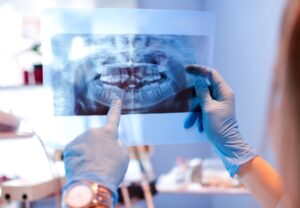
The jaw bones are actually kept healthy by the presence of tooth roots. These roots provide stimulation to the bone as well as nourishment that feeds through the tooth’s interior.
When a tooth is removed, so is the stimulation and nourishment to that area of the jaw bone. Without it, the bone begins to shrink. As it declines in height, the adjacent teeth are more vulnerable to loss. Statistics show that teeth adjacent to areas where natural teeth are missing will be the most likely to be lost next.
This has a domino effect. Partials can replace the presence of teeth above the gum line, but there is nothing to benefit the jaw bones below. Thus, tooth loss continues and can go from a few missing teeth to losing all teeth (being “edentulous”).
According to the Center for Disease Control & Prevention (CDC), 69 percent of adults between the ages of 35 – 44 have lost at least one permanent tooth. By age 50, Americans are missing an average of 12 teeth. For adults between the ages of 65 – 74, 26 percent are missing all of their natural teeth. That’s over one-fourth of the adult population over age 65.
Although dentures and partials mimic the presence of teeth, the jaw bones below are shrinking away, and at a rather rapid pace. The pressure of wearing a denture or partial actually speeds this process up, known as “resorption.”
As these bones decline in mass, deep wrinkles form around the mouth. The corners of the mouth turn downward. The chin takes on a more pointed form and the mouth sinks into the face. The nose seems to get closer to the chin as the jaw bones thin. Jowls form as facial muscles detach from shrinking bone structure.
Dental implants were designed to recreate the presence of natural teeth both above and below the gum line. Because teeth attached to the implants are supported by the jaw bones, the study foundation restores the ability to bite and chew without movement or fear of embarrassing slips.
For patients who are missing a great deal of bone, we offer bone rebuilding that does not require a bone graft. We also perform sinus lifts (when the upper jaw has declined to a significant level) to restore sufficient bone distance between vital structures.
For many of our dental implant patients, their lives become more active with the restored confidence. They become more socially involved, have more self-confidence and higher self-esteem.
Although dentures and partials may seem to be a less-expensive way to replace teeth, the savings is hardly worth the detrimental repercussions associated with them. Too, the upkeep required for dentures over time is actually high, considering replacement, relines and repairs.
As a periodontal specialist serving Western NC, I take great pride in the diagnosis and placement of dental implants. Each is selected based upon the patient’s individual needs and goals. We provide oral or I.V. sedation to ensure a comfortable experience and a friendly, respectful environment.
Begin with a friendly conversation in our private consultation room. In this comfortable setting, we’ll discuss your options and I’ll answer your questions. For many people, they are able to make a decision on how they wish to proceed after this conversation, even if it’s to go forward with dentures. We are supportive of each person’s preferences.
Call 828-274-9440 to schedule a consultation in our state-of-the-art Asheville periodontal dental office. I think you’ll feel especially confident in learning about our specialized skills and highly-advanced technology, not available in many dental offices in this area.
Recent Posts
Categories
Archives
- September 2024
- August 2024
- July 2024
- June 2024
- May 2024
- April 2024
- March 2024
- February 2024
- January 2024
- December 2023
- November 2023
- October 2023
- September 2023
- August 2023
- July 2023
- June 2023
- May 2023
- April 2023
- March 2023
- February 2023
- January 2023
- December 2022
- November 2022
- October 2022
- September 2022
- August 2022
- July 2022
- June 2022
- May 2022
- April 2022
- March 2022
- February 2022
- January 2022
- December 2021
- November 2021
- October 2021
- September 2021
- August 2021
- July 2021
- June 2021
- May 2021
- April 2021
- March 2021
- February 2021
- January 2021
- December 2020
- November 2020
- October 2020
- September 2020
- August 2020
- July 2020
- June 2020
- May 2020
- April 2020
- March 2020
- February 2020
- January 2020
- December 2019
- November 2019
- October 2019
- September 2019
- August 2019
- July 2019
- June 2019
- May 2019
- April 2019
- March 2019
- February 2019
- January 2019
- December 2018
- November 2018
- October 2018
- September 2018
- August 2018
- July 2018
- June 2018
- May 2018
- April 2018
- March 2018
- February 2018
- January 2018
- December 2017
- November 2017
- October 2017
- September 2017
- August 2017
- July 2017
- June 2017
- May 2017
- April 2017
- March 2017
- February 2017
- January 2017
- December 2016
- November 2016
- October 2016
- September 2016
- August 2016
- July 2016
- June 2016
- May 2016
- April 2016
- March 2016
- February 2016
- January 2016
- December 2015
- November 2015
- October 2015
- September 2015
- August 2015
- July 2015
- June 2015
- May 2015
- April 2015
- March 2015
- February 2015
- January 2015
- December 2014
- November 2014
- October 2014
- September 2014
- August 2014
- July 2014
- June 2014
- May 2014
- April 2014
- March 2014
- February 2014
- January 2014
- December 2013
- November 2013
- October 2013
- September 2013
- August 2013
- July 2013
- June 2013
- May 2013
- April 2013
- March 2013
- February 2013
- January 2013
- December 2012
- November 2012
- October 2012
- September 2012
- August 2012
- July 2012
- June 2012


